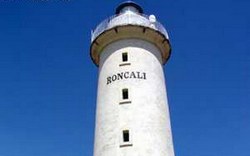Lighthouse Roncali in Guanahacabibes Peninsula illuminating the end western of Cuba
- Submitted by: admin
- Caribbean
- Environment
- history
- national
- Pinar del Río
- Society
- Business and Economy
- 05 / 12 / 2009

It is the permanent lab zone for diverse scientific observation and the monitoring of species of the flora and the fauna.
In 2004 "Ivan the terrible", as that devastating hurricane was called, slammed the peninsula.
After that, confirming that "butterflies fly in Guanahacabibes" was a good sign to prove that nature knows how to repair itself.
During a recent tour all over the peninsula, a team of reporters could ratify how the yana grows up beside fallen trees.
Researchers of Guanahacabibes and specialists of University of Havana take part in the monitoring of several species.
A few meters from Roncali lighthouse is located the synoptic station of Guanahacabibes, which measures meteorological variables like wind, humidity, temperature and whose installation is being repaired as part of the attention its stations network give to the country.
It is said that Cuba is the key to the Gulf given its geographic position, that's why the Cape San Antonio could be named as the tip of that key.
The surrounding international waters are a sea route, for which the lighthouse emits two flashes every 10 seconds and the sign can be seen from 30 kilometers; a guarantee for sailing.
Apart from the lighthouse- built between 1847 and 1850, the synoptic station with over 100 years of construction- has received new equipment that allows a faster access to Internet and therefore more precise measurements.
Young Yalesky Serrano, specialist in Meteorology notes the importance of these transformations.
Sat in front of the computer he explained the tense and hard work they formerly did.
"Sometimes we had the rain over our heads and we didn't know it. Then, we had to call the Provincial Meteorology Center to ask for data; but the winds of the South disorientated the former antenna and cut off the communication. New devices solved that problem.
The transmission of data is secure after the installation of a satellite antenna. Now we can even chat with the rest of the stations to exchange elements and make our work more reliable.
After his explanation he searches in the net and shows the forecast models they have access to, as well as satellite images and the messaging network.
Nothing will surprise them again. The use of technology provides them with better tools to carry out their labor.
The automatic station installed there sends data every 10 minutes to the Cuban capital, although it also continues with the measuring of variables.
For this commemoration, Sandino municipality is working hard in several aspects related to science and the environment, among them some actions to reduce the contaminant load, including the creation of oxidation ponds in Simon Bolivar pig breeding center.
(Guerrillero.cu)
Comments